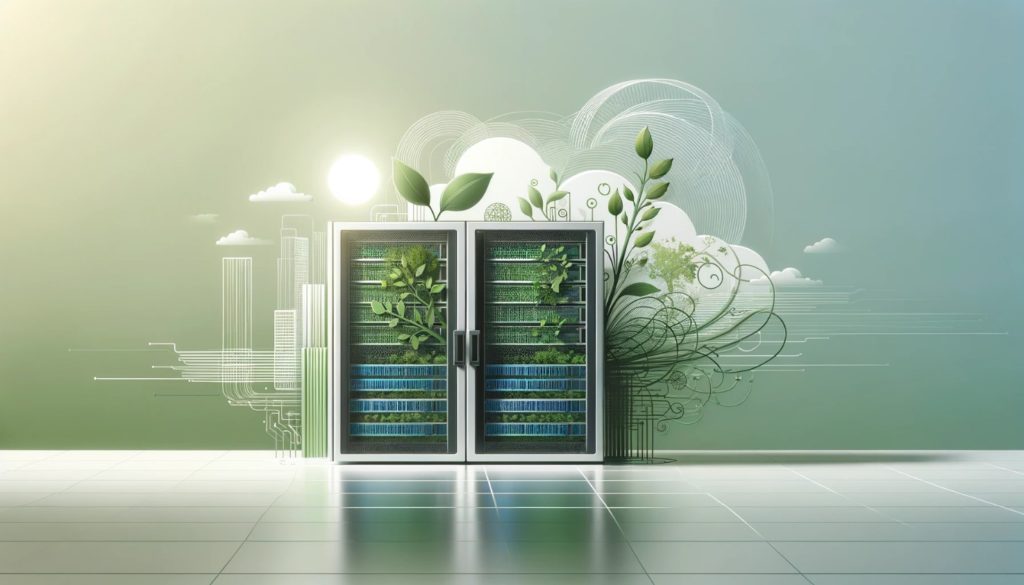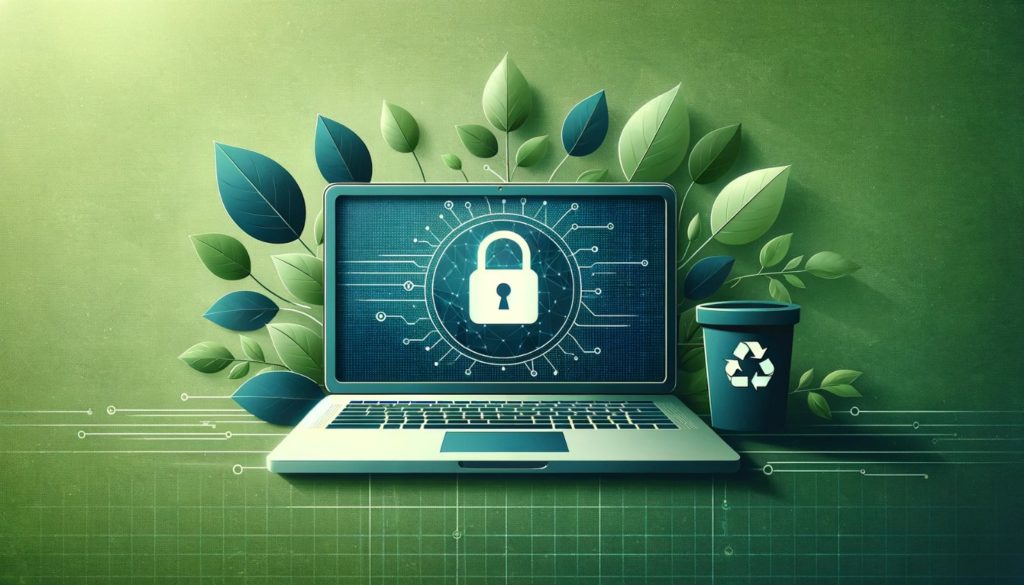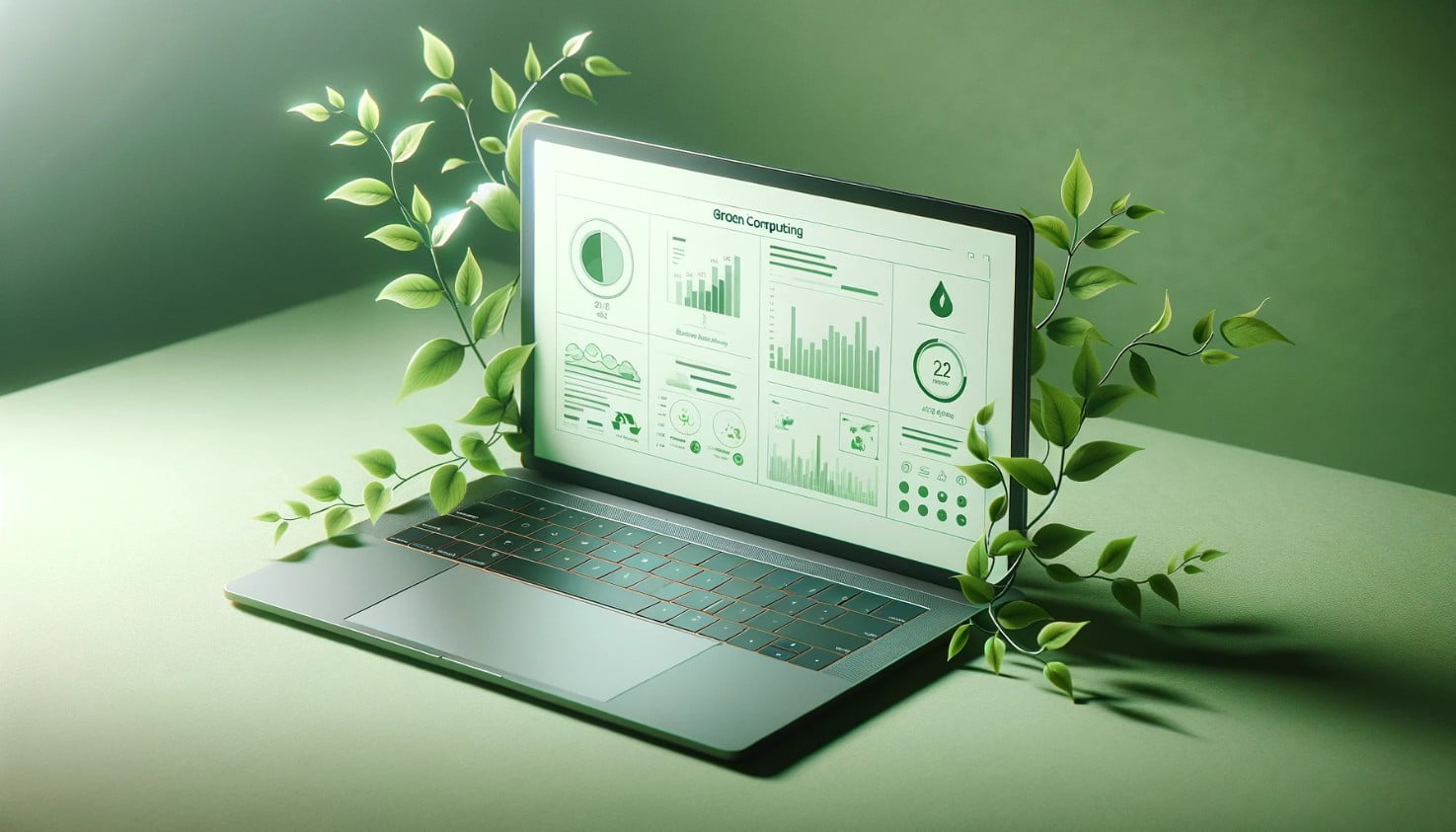
In an era where digital transformation is no longer a luxury but a necessity, the IT sector is facing a monumental challenge: how to align the ever-growing demand for technological advancement with the pressing need for sustainability. Green computing, also known as green IT, emerges as a critical response to this challenge, aiming to minimize the environmental impact of computing and IT services.
As we delve into the nuances of sustainable practices within IT infrastructure and cybersecurity, we understand that it’s not just about energy-efficient hardware but also about embedding sustainability into every facet of technology. The concept of green computing encompasses far more than hardware and infrastructure choices – it is a philosophy and culture that must permeate all levels of an organization.
The concept of green computing has gained traction over the years, propelled by a collective recognition of the environmental toll exerted by the IT industry. From colossal data centers guzzling electricity to outdated electronics swelling the heaps of e-waste, the digital world’s carbon footprint is substantial.
However, the tide is turning, with innovative solutions and strategies paving the way for a more sustainable IT landscape.
Redefining IT Infrastructure with Sustainability in Mind

At the heart of green computing lies the re-engineering of IT infrastructure to be more energy-efficient and environmentally friendly. This encompasses a broad spectrum of initiatives, from server virtualization to eco-friendly data center designs.
For instance, Cisco has been at the forefront of this green revolution, unveiling initiatives aimed at reducing the environmental impact of technology, which resonates with the ethos of Micro2media’s commitment to sustainability (Cisco’s Green Initiative).
Even the realm of cybersecurity is not immune to green influences. As cloud computing becomes ubiquitous, cybersecurity strategies must adapt not only to safeguard data but also to embrace sustainable practices. A significant portion of cyber vulnerabilities reside within the cloud environment, necessitating a green approach to cloud security.
Implementing green computing principles requires a shift in mindset and operations, but the long-term benefits make it a worthwhile endeavor. It is a journey towards an IT ecosystem that not only protects the environment but also fortifies the digital world against emerging threats.
Sustainable Practices in IT Infrastructure
In the quest for a greener digital footprint, sustainable practices in IT infrastructure play a pivotal role. The adoption of energy-efficient hardware and data centers is not just a nod to environmental stewardship; it’s a comprehensive strategy that intertwines operational excellence with ecological responsibility.
Eco-friendly servers and storage solutions reduce power consumption and heat output, pivotal in shrinking an organization’s carbon footprint. The use of efficient hardware lays the foundation for an environmentally conscious IT infrastructure.
Advanced cooling systems, such as liquid or outdoor air cooling, offer innovative ways to manage data center temperatures sustainably (Micro2media’s Green Data Centers). By leveraging methods like specialized cooling rather than traditional AC, data centers can achieve drastic reductions in electricity usage.
Power management software tracks and optimizes energy use, ensuring devices are only fully powered when necessary. The intelligent direction of power allows organizations to minimize energy waste without affecting performance.
Cloud computing, with its inherent scalability and resource optimization, stands as a testament to the power of virtualization in reducing the number of physical servers required. This service model not only conserves energy but also enhances flexibility and accessibility, crucial in today’s mobile-centric world.
As cybersecurity becomes increasingly paramount, the intersection of security and sustainability has never been more relevant. A secure cloud environment is not only crucial for protecting data but also for ensuring that sustainable practices are not compromised by cyber threats.
Cybersecurity strategies and green computing initiatives must evolve together, rather than in conflict, to create secure and sustainable systems. The collaborative effort between cybersecurity and green computing is essential for creating an IT infrastructure that is both secure and sustainable. This includes everything from secure coding practices to the deployment of energy-efficient security appliances. Through a combined approach, organizations can protect critical assets while reducing environmental impact.
Cybersecurity and Green Computing
As our reliance on digital infrastructure grows, the need for robust cybersecurity measures becomes more pressing. However, security doesn’t have to come at the expense of the environment. Green computing principles are being integrated into cybersecurity strategies to achieve a balance between protecting digital assets and the planet.
Software development is undergoing a significant transformation with an increased focus on energy efficiency. Developers are now giving priority to two key areas:
- First, they are concentrating on creating optimized algorithms that demand less computational power. This approach not only reduces energy consumption but also leads to a direct decrease in electricity usage across an organization’s systems.
- Second, there is a growing emphasis on developing resource-efficient software. Such software is designed to extend the lifespan of hardware, which in turn lessens the need for frequent hardware updates and contributes to a reduction in electronic waste.
Alongside these developments, Artificial intelligence (AI) and machine learning (ML) are not only transforming business operations but also leading the charge in energy-efficient computing. AI algorithms can be trained to optimize energy usage across IT systems, predictively managing workloads to reduce the carbon footprint.
For example, the Carbon Aware SDK initiative by the Green Software Foundation represents a significant advancement in carbon-aware computing, enabling workloads to run on the greenest energy sources available (MIT Technology Review on Carbon-Aware Computing).

Leveraging AI and ML unlocks new potential for sustainability, allowing systems to automatically improve their energy efficiency over time. Green computing also extends to data protection measures, ensuring that sustainable IT systems maintain the highest security standards. Energy-efficient firewalls and security appliances not only safeguard against cyber threats but also contribute to the overall reduction in energy usage.
Cybersecurity practices are currently being reevaluated with a strong emphasis on sustainability. This shift involves a couple of key approaches:
First, sustainable cybersecurity policies are being integrated with green principles. These policies ensure that security measures align with and contribute to an organization’s overarching sustainability objectives. By incorporating environmental considerations, cybersecurity strategies are developed more holistically, moving away from being designed in isolation.
Second, there is an increasing adoption of eco-friendly cybersecurity products. These products deliver the same level of security as their traditional counterparts but with a reduced environmental footprint.
Examples include biodegradable security tokens and solar-powered security cameras. Such innovations enable businesses to enhance their security measures in an environmentally conscious manner.
The integration of sustainable practices within IT infrastructure, particularly in cybersecurity, is a testament to the IT industry’s commitment to a greener future. By leveraging energy-efficient technologies and green software development, the cybersecurity sector not only ensures the safety of digital assets but also supports the global sustainability agenda.
This fusion of security and efficiency creates a win-win scenario: robust data protection paired with ecological stewardship. It’s a dual effort that fortifies digital defenses while preserving the environment, ensuring a secure and sustainable digital landscape for years to come.
Economic Benefits and Cost Savings
The shift toward green computing not only serves an environmental imperative but also offers compelling economic advantages for businesses. The implementation of sustainable IT practices is a powerful catalyst for cost savings, operational efficiency, and enhanced corporate reputation.
By incorporating energy-efficient devices and optimizing software, organizations can significantly lower their energy consumption, translating directly into reduced utility expenses. Minimizing power usage through green computing provides immediate and tangible financial gains.
Green computing extends the life of IT hardware. Through efficient resource allocation and reduced wear and tear, companies can defer the financial burden of frequent hardware replacements. Hardware longevity is a key sustainable benefit that saves money previously spent on upgrades and replacements.
Virtualization and cloud computing facilitate more efficient use of hardware resources, leading to reductions in both setup and ongoing maintenance costs. Transitioning physical infrastructure to the cloud shifts expenses from capital costs to operating costs while driving efficiency.
Regulatory Compliance and Standards
Beyond the immediate financial benefits, green computing aligns with an increasingly stringent regulatory landscape. Companies adhering to green IT policies not only mitigate risks of non-compliance but often benefit from governmental incentives.
Energy Star and EPEAT are examples of certifications that help guide consumers and businesses towards environmentally friendly products, while laws and directives mandate responsible e-waste disposal and energy consumption. Obtaining green certifications not only signals a commitment to sustainability, but also ensures compliance with current and emerging regulations.
The transition to green IT requires a cultural shift within organizations. Education and awareness programs are crucial for informing stakeholders about the benefits and practices of green computing, and many organizations provide incentives for sustainable initiatives. Effecting real change relies on stakeholders at all levels embracing the ethos of environmental stewardship.
Case Studies and Industry Examples
The power of green computing is vividly illustrated through case studies and examples from leading organizations. By examining these, we gain insights into how companies have successfully navigated the path to sustainability, often becoming benchmarks for the industry.
Tech giants have set the stage for green data centers. Google’s commitment to 24/7 carbon-free energy by 2030 and Facebook’s PUE (Power Usage Effectiveness) of their data centers are examples of how the industry is striving for sustainability. These efforts not only reduce their environmental impact but also demonstrate the practicality of green initiatives in large-scale operations.
HP and Dell are among companies leading the way in sustainable hardware. By using recycled plastics and other materials in their devices, they are making significant strides in reducing e-waste. Incorporating recycled and renewable materials into manufacturing helps complete the product lifecycle in an eco-friendly way.
Challenges and Considerations
Despite these successes, the road to green computing is paved with challenges. Organizations must weigh the initial costs of sustainable infrastructure against the long-term savings and consider the potential for technological limitations that could hinder performance.
The upfront cost of green technologies can be significant, and there may be performance trade-offs in the short term. As these technologies evolve, however, they are rapidly closing the gap on their traditional counterparts in terms of performance and reliability. The higher capital costs require a long-term mindset focused on total cost of ownership, as the sustainability benefits accrue over years rather than months.
Challenges in Adoption:
- Organizations must navigate the challenges of adopting green technologies.
- Balancing upfront costs with long-term gains adds complexity to decision-making.
Educating stakeholders about the advantages and practices of green computing is essential. It requires not only information dissemination but also a cultural shift within organizations to value and prioritize sustainability.
Stakeholder Engagement:
- Making the case for sustainability and driving adoption at scale relies on stakeholder engagement at all levels.
- A collaborative effort is crucial for fostering a culture of sustainability within organizations.
Navigating the complex landscape of environmental regulations remains a challenge, especially for multinational corporations that must comply with a variety of regional standards. Keeping up with these ever-changing regulations requires a dedicated effort. Monitoring and adapting to shifting regulations across markets is an ongoing obstacle, despite the shared goal of ecological stewardship.
Global Compliance Challenges:
- Multinational corporations face challenges in complying with diverse regional environmental standards.
- The complexity of regulatory landscapes demands continuous efforts for global compliance.
A truly green IT operation means ensuring all components are sustainable. Sourcing eco-friendly materials that meet performance standards and ensuring suppliers adhere to green practices adds another layer of complexity to the challenge. Expanding sustainability across the entire supply chain introduces further intricacies but is vital for making meaningful progress.
The Future of Green IT
The IT industry stands on the brink of a new era, where sustainability will become the norm rather than the exception. This future is ripe with opportunities for innovation, growth, and a stronger commitment to environmental care.
Scalability and sustainable growth are underpinned by green computing, which is more than just a trend; it’s essential for scalable and sustainable growth in the IT sector. The increasing prevalence of cloud solutions and green data centers enables businesses to expand without significantly increasing their carbon footprint. The flexibility and efficiency of cloud infrastructure support responsible growth, even on a large scale.
Experts anticipate a surge in renewable energy use for IT operations and a growth in sustainable procurement practices. As public awareness of environmental issues increases, so does consumer demand for green products and services, spurring further innovation. Momentum around sustainability is accelerating due to technological advancements, public awareness, and consumer choices.
The demand for green technologies is a strong driver for research and development. Innovations in new materials, energy storage solutions, and AI are revolutionizing the industry, leading to more environmentally friendly IT solutions. Continuous innovation across various disciplines is unlocking new possibilities for energy efficiency and waste reduction.
As governments worldwide implement stricter environmental regulations, green IT practices will become essential for compliance. Global initiatives like the Paris Agreement highlight the need for collective action against climate change, with IT playing a crucial role. Tighter regulations will embed sustainability into standard business operations as environmental standards become more unified.
The move towards a greener IT industry is a collaborative effort, involving innovators, policymakers, and technology users. Looking to the future, it’s evident that our current decisions will have long-lasting effects, shaping a digital world that is secure, efficient, and environmentally harmonious. Through the collective efforts of all stakeholders, we can build a sustainable future based on responsible computing.
Incorporating insights from MJV’s blog, the IT industry is clearly evolving towards a sustainable model. For more information on the transformative role of green IT, MJV’s insightful discussion on the topic is a valuable resource.
Conclusion:
In conclusion, green computing represents a vital and growing movement within the IT industry, driven by the imperative to reduce environmental impact and optimize resource use. By integrating sustainable practices in hardware design, software development, data center operations, and cybersecurity, companies can achieve significant energy savings, reduce carbon emissions, and enhance their corporate responsibility. The adoption of green computing is not without its challenges, including initial investment costs and the need for cultural shifts within organizations.
However, the long-term benefits, including cost savings, improved efficiency, and compliance with evolving environmental regulations, make it a compelling strategy. As technology continues to evolve, green computing will undoubtedly play a crucial role in shaping a more sustainable and environmentally responsible future in the digital world.
